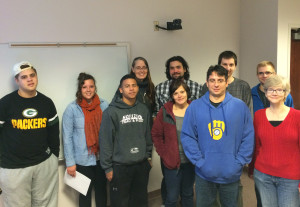Verb Type 2 – How to Say Someone Does Something
Anishinaabemowin is a language focused on describing the world and the action that takes place in it. Before any sentence can be understood, a speaker or listener will ask, “What is happening and who or what is involved?” The answer to those questions will determine which verb is used.
The second type of verb is sometimes called the Intransitive Animate but “Type 2” also works.
Verb Type 2 is used when one of the seven kinds of “actors” or “pronouns” does something. Speakers add to the word to show who did it. The table below explains what is added to a “root” verb.
Pronoun in Ojibwe |
Pronoun in English |
Single Statement or “ina” Questions |
| niin | I | ni + verb nin (initial d,j,g,z,zh) *also remove only nim (initial b) the last “i” or “o” nind (initial vowel) |
| giin | you | gi + verb *also remove only gid (initial vowel) the last “i” or “o” gim (initial b) |
| wiin | he / she | o + verb *the “o” is optional |
| niinawind | just us | ni + verb + min nin (initial d,j,g,z,zh) nim (initial b) nind (initial vowel) |
| giinawind | all of us | gi + verb + min gid (initial vowel) gim (initial b) |
| giinawaa | you all | gi + verb + m gid (initial vowel) gim (initial b) |
| wiinawaa | them | o + verb + wag (final vowel) *”o” is optional o + verb + oog (final consonant) |
Here are some Type 2 root verbs. They will become the center of your statement as you add meaning.
- wiisni – to eat
- giishkaabaagwe – be thirsty
- zhoomiingweni – to smile
- minawaanigozi – happy
- debwe – true / honest
- bakade – hungry
- ayekozi – tired
- aakozi – sick
- bimibatoo – run along
- bimose – walk
- inendam – to think / agree
- gaagiigido – talk
- bimaadizi – to live
- izhinikaazo – to be named
- bagizo – to swim
- odamino – to play
- dagoshin – to arrive
- biindige – to enter
- niimi – to dance
- nibaa – to sleep
- bakinaage – to win
- ozhibii’ige – to write
To begin a sentence, choose a root verb. Then indicate who is doing the action by adding the right parts to the front and/or back of the root verb. There is no need to say the actual pronoun unless you want to be very very emphatic. For example: Nimbakade. = I am hungry. Niin nimbakade. = Me, I am hungry!
It helps to think of it as an equation:
- ni + wiisin (take away the “i”) = I am eating
- gi + wiisin (take away the “i”) = you are eating
- o + wiisini (with no changes and the “o” is optional) = he or she is eating
- ni + wiisini + min = just us (the speaker and someone, not including the listener) are eating
- gi + wiisini + min = all of us (the speaker and someone and the listener) are all eating
- gi + wiisini + m = yous (more than one of you) are eating
- o + wiisini + wag (the “o” is optional) = they are eating
Aanikanootan (Translate It)
Translate these sentences created by the students in the First Year Anishinaabemowin class at the University of Wisconsin-Milwaukee. Then try to write your own!
Please note: In real speech there is variation that listeners learn to hear beyond. Some people have accents they picked up from their home community, others are learning the language for the first time. Being able to become fluent depends on the ability to understand a wide range of pronunciation.
Verb Types 2 Student Sentences
- Ningiishkaabaagwe.
- Gigaagiigid.
- Ayekozi.
- Nizhoomiingwenimin.
- Gibimosem.
- Bimibatoowag.
- Gidodaminomin.
- Obindige.
- Onibaawag.
- Nimbakade.
- Nindebwemin.

